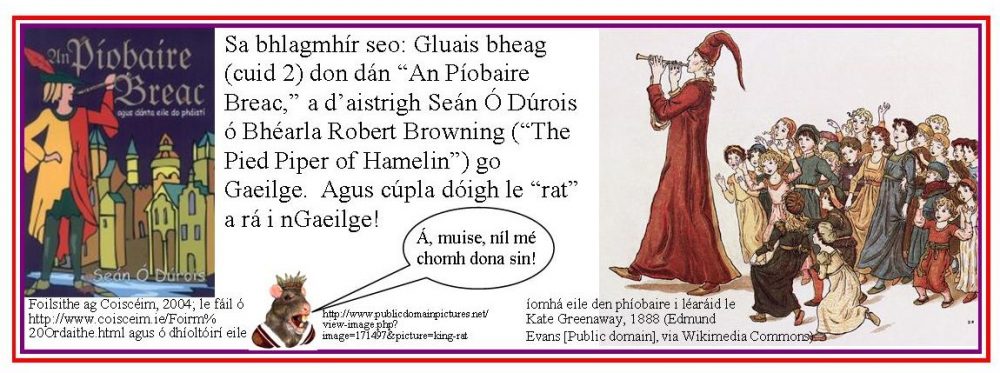How to say ‘rat’ in Irish and a continuation of the glossary for ‘An Píobaire Breac’ (an t-aistriúchán le Seán Ó Dúrois) (Cuid 2) Posted by róislín on Sep 25, 2017 in Irish Language
(le Róislín)
Today we’ll continue the glossary started in the previous blog (nasc thíos) to help with reading “An Píobaire Breac,” Seán Ó Dúrois’s lively translation of Robert Browning’s “The Pied Piper of Hamelin” (Eolas foilseacháin thíos).
First a brief review from last time. There are two main ways to say “rat” in Irish, one with several variations.
a)) Probably the most basic is “francach,” with the following forms:
francach, an francach, an fhrancaigh, na francaigh, na bhfrancach (e.g. eireabaill na bhfrancach, the tails of the rats). As mentioned before, if capitalized, this means “Frenchman.” as in “bairéad an Fhrancaigh, the beret of the Frenchman” or “bairéid na bhFrancach, the berets of the Frenchmen.” To which I can only say, hmmm.
b)) The second main way to say “rat” is based on the word for mouse, “luch” or “luchóg.” There are at least three variations: luch mhór, luch fhrancach, and luchóg mhór. Literal translations and some of their various inflections are given in the nótaí at the end of this post. The one variation that I haven’t seen anywhere, at least so far, is “luchóg” + “francach” (which would end up lenited as “fhrancach“). Presumably that’s just logical, since “luchóg” suggests “small” but rats are relatively large. Anyway, if anyone spots this variation, I’d be glad to know.
Two related words are “francaire” and “luchaire,” both meaning “rat-catcher.” The latter (“luchaire“) can also mean “mouse-catcher, mouser, or ratter.” Curious, because “mouser” sounds like a cat, to me, while “ratter” sounds like a dog. Unless, of course, the “ratter” is a person, in which case, it’s usually a “fealltóir” (also betrayer or traitor) or a “loiceach” (also, a defaulter, or in politics <chuckle>, a scuttler).
And now, a few more additional words from the text of “An Píobaire Breac,” starting with Stanza 9:
Stanza 9: ciúnas, which may also be spelled “ciúineas” elsewhere, quietness
Stanza 10: Mar gheall ar an dóigh a mbím ag seinm, because of the way I play, or more literally “because of the way in which I am playing.” It’s a constant issue, in learning Irish, to decide if lenition or eclipsis follows the pre-verbal particle “a.” One way I like to think of it is, if you can say, “in which” (or “to which,” “at which,” “of which,” etc.), it’s most likely going to be eclipsis. In theory, the rules for this are clear-cut, delineating direct and indirect relative clauses (cf. Progress in Irish, Ceachtanna 61 & 62, Clásail Choibhneasta, or Learning Irish, Ceachtanna 13 & 18, or Gramadach gan Stró, Aonad 16, among other textbook treatments of the topic). But, in practice, I think that most people find that learning the rules and being able to apply them spontaneously in speech are quite different.
Stanza 10: Lubliana, príomhchathair na Slóvéine, go hoifigiúil i nGaeilge “Liúibleána agus “Ljubljana” sa tSlóvéinis)
Stanza 10: earc, lizard (aka “laghairt” i nGaeilge) or reptile (aka reiptíl OR uathphéist i nGaeilge), and in various combinations, “newt” or “eft”
Stanza 10: cruimh, maggot
Stanza 10: sciathán leathair, a bat, lit. leatherwing (which is sometimes also used in English)
Bhuel, it looks like this blogpost will stretch into at least “cuid a trí” since we’re not even halfway through yet. Tá súil agam go bhfuil tú ag baint suilt as seo agus más múinteoir thú, go bhfuil sé úsáideach i rang.
BTW, some day maybe I’ll check the literal translations against Browning’s original English, but for right now, our goal is just to understand the Irish, inside and out, backwards and forwards, literally and, where applicable, figuratively, which is what I always strive for. Sometimes, though, of course, we can be satisfied just getting the gist (an éirim, an bhrí or an bunús) of the situation! SGF — Róislín
Nótaí:
luch mhór (lit. big mouse); an luch mhór, na luiche móire, na lucha móra, na luch mór (a great reinforcement of Progress in Irish, Ceacht 68, Díochlaonadh na hAidiachta [The Declension of Adjectives)
luch fhrancach (lit. rat-mouse or French mouse, though the word is usually capitalized when it really means “French”); an luch fhrancach, na luiche francaí, na lucha francacha, na luch francach
luchóg mhór (also means “big mouse,” but with the suffix “-óg,” which usually implies “young” or “little”); an luchóg mhór, na luchóige móire, na luchóga móra, na luchóg mór
Nasc: How to say ‘rat’ in Irish and an additional glossary for reading ‘An Píobaire Breac’ (an t-aistriúchán le Seán Ó Dúrois) (Cuid 1 as 4) Posted by róislín on Sep 23, 2017 in Irish Language
Eolas foilseacháin: Ó Dúrois, Seán. An Píobaire Breac agus dánta eile do pháistí. Binn Éadair, Baile Átha Cliath, 2004. Gan ISBN sa chóip atá agamsa. I measc áiteanna eile tá an leabhar ar fáil ó https://www.cic.ie/books/published-books/an-piobaire-breac-danta-eile-do-phaisti-leabhair-cloite agus https://www.litriocht.com/product/an-piobaire-breac-agus-danta-eile-do-phaisti/ agus http://www.coisceim.ie/2004.html

Build vocabulary, practice pronunciation, and more with Transparent Language Online. Available anytime, anywhere, on any device.





Leave a comment: